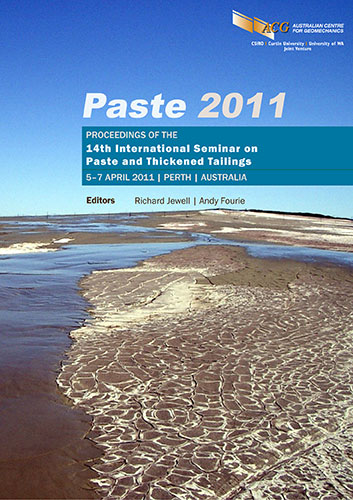Field trials of thin-lift deposition of amended mature fine tailings at the Muskeg River Mine in Northern Alberta

|
Authors: Matthews, JG; Dhadli, N; House, P; Simms, P |
DOI https://doi.org/10.36487/ACG_rep/1104_25_Matthews
Cite As:
Matthews, JG, Dhadli, N, House, P & Simms, P 2011, 'Field trials of thin-lift deposition of amended mature fine tailings at the Muskeg River Mine in Northern Alberta', in R Jewell & AB Fourie (eds), Paste 2011: Proceedings of the 14th International Seminar on Paste and Thickened Tailings, Australian Centre for Geomechanics, Perth, pp. 271-280, https://doi.org/10.36487/ACG_rep/1104_25_Matthews
Abstract:
In response to regulatory directives that tailings achieve a given shear strength within a certain time subsequent to deposition, oils sands operations in Northern Alberta are aggressively investigating several new deposition techniques. Shell has plans to deploy a number of tailings management technologies that will deliver on corporate sustainability objectives and regulatory requirements. Technologies currently planned for deployment are identified in Shell regulatory submissions and include thickened tailings, composite tailings, non-segregating tailings, centrifugation of fine tailings, and atmospheric fines drying. This paper will provide a brief introduction to atmospheric fines drying (AFD) process. The AFD process entails amendment of fluid fine tailings (FFT) with a flocculating polymer such that rheology and depositional characteristics are modified, water release is enhanced upon deposition and the deposits are managed to enhance the rate of dewatering such that the fluid tailings have geotechnical strength properties. Shell Canada commenced large scale AFD trials in August 2010. The field program involves nine separate cells, each 30,000–40,000 m2 in plan, approximately 300 m long, radiating from a central staging area. Each cell is graded with a designated slope, ranging from 0.5–1.5%. The cells are separated by berms. A range in lift sizes (0.1–0.5 m) are to be investigated as a controlling parameter for AFD performance. The paper documents some preliminary results from the operation with respect to i) achieving a given level of polymer mixing and controlling the rheology of the tailings emerging the pipe, ii) controlling the geometry of the tailings during deposition, and iii) the degree of densification and shear strength gain achieved by settling, consolidation, and desiccation.
References:
Baskerville, R.C. and Gale, R.S. (1968) A Simple Automatic Instrument for Determining the Filterability of the Sewage Sludge, Water Pollution Control, Vol. 67, pp. 233–234.
Energy Resouces Conservation Board (ERCB) (2009) Directive 074: Tailings Performance Criteria and Requirements for Oil Sands Mining Schemes, February 2009.
Pashias, N., Boger, D.V., Summers, J. and Glenister, D.J. (1996) A fifty cent rheomoter for yield stress measurement, Journal of Rheology, Vol. 40(6), pp. 1179–1189.
© Copyright 2025, Australian Centre for Geomechanics (ACG), The University of Western Australia. All rights reserved.
View copyright/legal information
Please direct any queries or error reports to repository-acg@uwa.edu.au
View copyright/legal information
Please direct any queries or error reports to repository-acg@uwa.edu.au